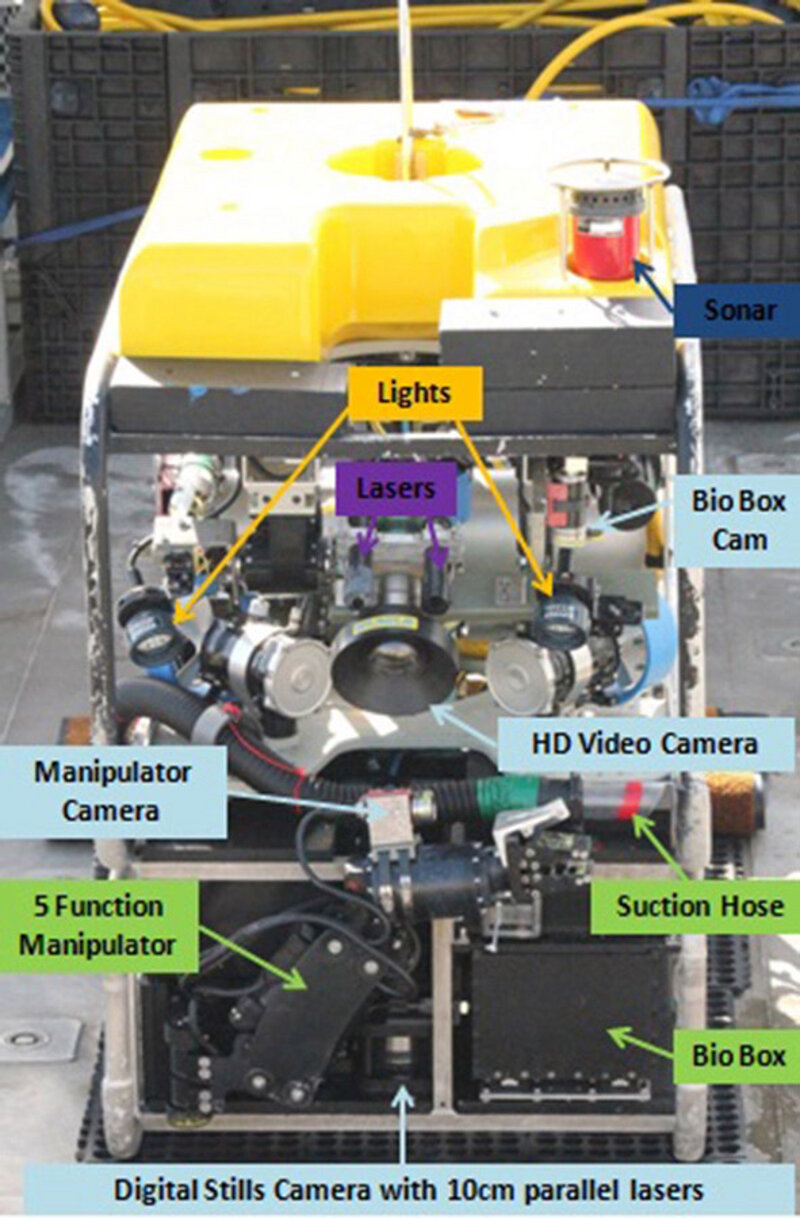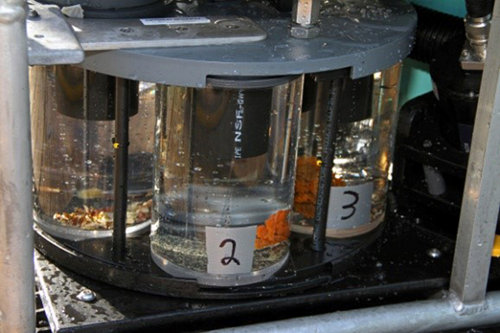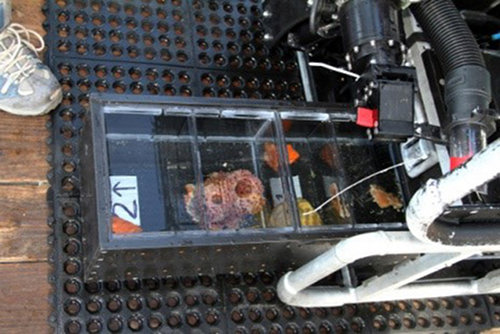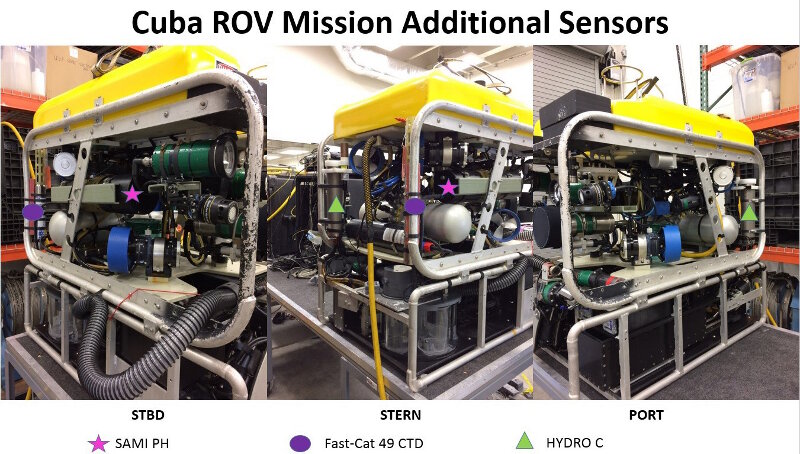
By Jason White, ROV Pilot/Technician - Undersea Vehicles Program, University of North Carolina Wilmington
May 19, 2017

Figure 1. The Mohawk ROV with some of its key parts labeled. Image courtesy of Undersea Vehicles Program, University of North Carolina Wilmington; Cuba’s Twilight Zone Reefs and Their Regional Connectivity. Download image (jpg, 150 KB).
The University of North Carolina Wilmington’s Undersea Vehicles Program (UVP ) will be providing its Mohawk remotely operated vehicle (ROV) and pilots/technicians for this research mission. The Mohawk is a 300-meter science class ROV consisting of five thrusters, high-definition (HD) video camera, 10-Mp digital stills camera, two sets of lasers for scaling, lights, and a collection skid (Figure 1).
The Mohawk ROV’s primary purpose is to document the undersea environment using video cameras and the digital stills camera. The HD video footage allows for excellent playback abilities for the scientists to review the dives repeatedly for different scientific objectives. The 10-Mp digital stills camera has two main purposes; it provides the ability to do spatial counts of different organisms like coral with software like coral point count and for high-quality photographic pictures of the underwater environment.
In addition to video documentation, the collection skid allows the ROV to collect samples during a dive. The collection skid was designed and built at Harbor Branch Oceanographic Institute by Bill Baxley with the goal of replicating many of the collection abilities the Johnson Sea Link manned submersible had, but on a smaller scale.
There are two main purposes for the samples: species identification and genetic sequencing. The collection skid consists of three main pieces of equipment. The skid has an electric five-function manipulator on the front starboard side, which allows scientists to pick up different samples to place in the bio box.

Figure 2. The suction carousel with sponges and coral in the discrete two-liter buckets. Image courtesy of Undersea Vehicles Program, University of North Carolina Wilmington; Cuba’s Twilight Zone Reefs and Their Regional Connectivity. Download image (jpg, 49 KB).
The next piece of equipment is the suction sampler (Figure 2). The suction sampler consists of a two-inch vacuum hose that can be gripped and guided by the manipulator. The amount of suction and direction of flow is controlled by a variable speed, reversible pump. The hose goes to one of five discrete two-liter buckets, which can be rotated into place for the next suction sample.

Figure 3. The bio box with dividers and full of sponges. Image courtesy of Undersea Vehicles Program, University of North Carolina Wilmington; Cuba’s Twilight Zone Reefs and Their Regional Connectivity. Download image (jpg, 58 KB).
The last piece of equipment on the collection skid is the bio box (Figure 3). The bio box uses a chain drive to open and close the box on command. This is where we can store multiple samples that you pick up with the manipulator jaws. The bio box is 24 inches long, 9 inches wide, and 7.5 inches deep. It can be left completely open, or separators can be added to divide the bio box into ficw discrete sections.
To date, the Mohawk ROV has collected 298 samples using the collection skid. During this cruise, UVP anticipates collecting corals, sponges, sediment, gorgonians, algae, and other items on the seafloor. The goal for this cruise is collecting 300 samples!!!
If you would like to see more pictures and video of the Mohawk ROV and collection skid in action in Cuba, please see our Facebook page.

Figure 4. Mohawk ROV with the additional sensors attached for this expedition. Image courtesy of Undersea Vehicles Program, University of North Carolina Wilmington; Cuba’s Twilight Zone Reefs and Their Regional Connectivity. Download larger version (jpg, 352 KB).
The collection skid was also designed with the capability to allow us to “plug and play” different scientific instruments that can be integrated onto the ROV (Figure 4). The skid can provide 24 VDC power in addition to RS-232, RS-485 and Ethernet communication protocol.
On this mission, we are using a FastCat Seabird CTD, Sami-pH sensor, and a HYDRO C sensor to collect physical oceanographic data. The CTD collects continuous conductivity, temperature, and depth data while the ROV is in the water, and allows us to be more time-efficient since we don’t have to deploy the ship’s large CTD daily. The Sami-pH sensor collects continuous pH data and the HYDRO C sensor collects continuous carbon dioxide data while the ROV is conducting operations.
This will be UVP’s first time conducting ROV operations in Cuba. Over the last 15 years, UVP has conducted many ROV surveys in the Western Gulf of Mexico at Flower Garden Banks National Marine Sanctuary; at Pulley Ridge in the Eastern Gulf of Mexico; around the Dry Tortugas/Florida Keys area; and in the Caribbean, including Puerto Rico, St. Thomas, and St. Croix.
UVP is particularly interested to see how the waters surrounding Cuba compare to these other locations. UVP is also interested to compare the fishing pressure in Cuba nearshore waters compared to other Caribbean island locations like Puerto Rico, where locals fish nearshore waters heavily.